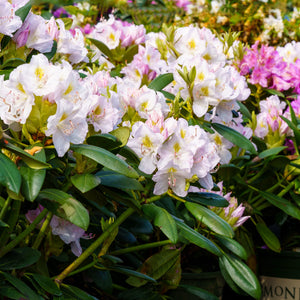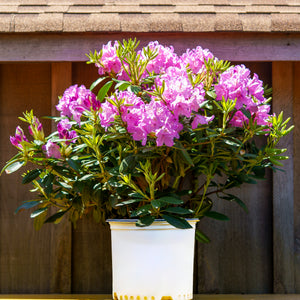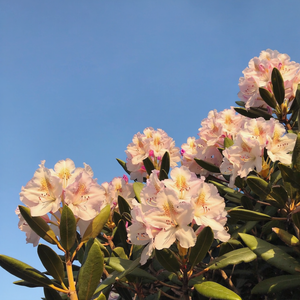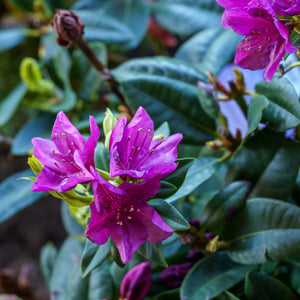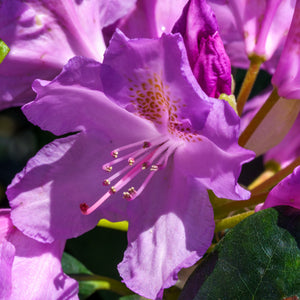The Rhododendron Guide
Rhododendrons (Rhododendron spp.) are beloved for their dramatic clusters of spring flowers, lush evergreen foliage, and ability to thrive in shady, acidic soils. With a wide range of sizes, colors, and growth habits, rhododendrons have become essential plants in foundation plantings, woodland gardens, and mixed shrub borders. Their adaptability to part shade, long lifespan, and low-maintenance needs make them a staple in both traditional and contemporary landscapes.
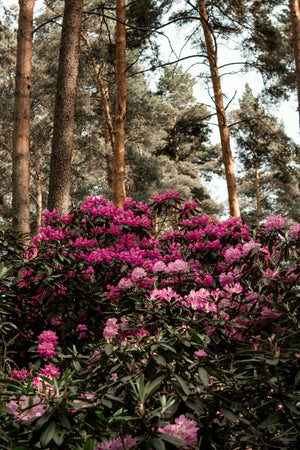
About
The genus Rhododendron contains over 1,000 species, including both evergreen and deciduous forms. These plants are primarily native to Asia, although some species are found in Europe and North America. In home gardens, rhododendrons are most commonly grown for their large trusses of bell-shaped flowers that bloom in shades of pink, purple, red, white, and yellow during spring.
Popular species and hybrids include:
- Rhododendron catawbiense: A hardy native to the eastern U.S., valued for its large purple flowers and resilience. Cultivars like 'Boursault' and 'Album' are widely used in Northeastern landscapes.
- Rhododendron maximum: Another eastern U.S. native, known for its tall, leggy growth and pale pink to white flowers. Often used in naturalistic plantings.
- Rhododendron yakushimanum: A compact, slow-growing species with woolly new growth and superior flower coverage. Selections like 'Ken Janeck' and 'Percy Wiseman' are garden favorites.
- Rhododendron x 'P.J.M.': A hybrid between Rhododendron carolinianum and R. dauricum, this early bloomer has lavender-pink flowers and outstanding cold hardiness.
Rhododendrons prefer cool roots, dappled sunlight, and rich organic soil. Their evergreen leaves add texture and color even after the bloom period, and some varieties offer bronze or purple winter tones. With options ranging from dwarf shrubs under 2 feet to towering forms over 10 feet tall, they can serve as hedges, accents, or structural anchors in the landscape.
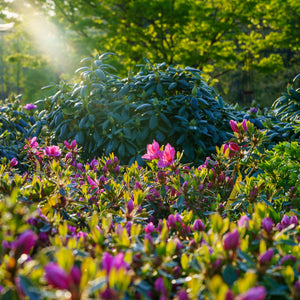
PLANTING
USDA Hardiness Zones: Most rhododendrons thrive in Zones 4–8. Check individual varieties for regional performance.
Soil: Rich, acidic soil (pH 4.5–6.0) with excellent drainage is essential. Amend with compost, pine fines, or peat moss as needed.
Sunlight: Partial shade is ideal—morning sun with afternoon protection helps avoid leaf scorch. Some varieties tolerate full sun in cooler climates.
Watering: Maintain consistent soil moisture, especially during establishment. Rhododendrons have shallow roots that dry out quickly.
Spacing: Plant based on mature width—typically 3 to 6 feet apart. Air circulation between plants helps prevent disease.
Planting Time: Early spring or fall is best. Avoid planting in summer heat or during extended drought.
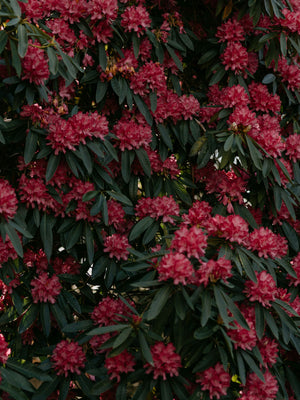
CARE
Watering: Water regularly, particularly during dry spells. Apply water directly to the root zone to avoid wetting foliage.
Fertilizing: Use an acid-loving plant fertilizer in early spring, just before buds open. Avoid overfeeding, which can harm roots and reduce blooming.
Pruning: Prune immediately after flowering if shaping is needed. Remove dead wood, damaged branches, or spent flowers to maintain vigor. Avoid hard pruning unless rejuvenating an old shrub.
Pests and Diseases: Watch for lace bugs, root weevils, and fungal issues like leaf spot or petal blight. Ensure good air circulation and avoid overhead watering.
Mulching: Apply 2–3 inches of mulch using pine needles, bark, or shredded leaves. Keep mulch away from the stem to prevent rot.
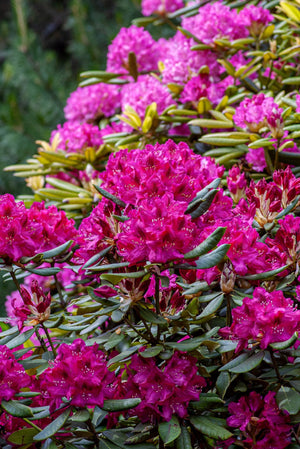
HOW TO USE
Focal Point: Large-flowered rhododendrons like Rhododendron x 'Nova Zembla' or 'Roseum Elegans' make excellent focal point plants in shady borders or foundation beds. Their spring blooms and structured form attract attention even when not in flower.
Woodland Gardens: Rhododendrons excel under tall trees with filtered light. Combine with ferns, Hellebores, and native azaleas for a layered woodland aesthetic.
Foundation Plantings: Compact varieties like 'P.J.M. Elite' and 'Olga Mezitt' work well near homes, offering year-round greenery and spring color without overpowering the architecture.
Mixed Borders: Plant with shade-tolerant companions like Pieris, Andromeda, Leucothoe, or Hydrangea serrata to create depth and seasonal interest.
Screening and Hedges: Tall cultivars such as Rhododendron maximum or 'English Roseum' can form living privacy walls when spaced and pruned appropriately.
Container Gardening: Dwarf varieties such as 'Purple Gem' or yakushimanum hybrids can be grown in large pots with acidic soil and regular watering.
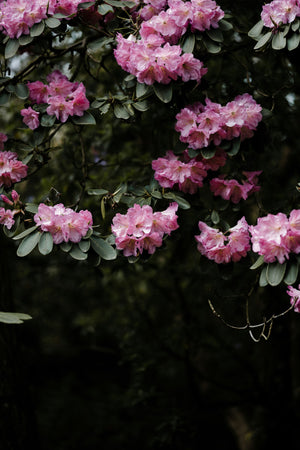
Common Questions
When do rhododendrons bloom? Most bloom in mid to late spring, though some hybrids bloom earlier. Bloom time depends on the variety and local climate.
When to prune rhododendrons? Prune just after flowering, before next year’s buds set. Minimal pruning is needed unless shaping or rejuvenating.
Do deer eat rhododendrons? Yes, rhododendrons are generally not deer-resistant and may need protection in areas with high deer pressure.
How to prune rhododendrons? Remove spent blooms and dead branches after flowering. For rejuvenation, cut back one-third of the shrub per year over several years.
Do rabbits eat rhododendrons? Occasionally. While not a preferred food source, young shrubs may be nibbled.
Are rhododendrons poisonous to dogs and cats? Yes, all parts are toxic if ingested and can cause serious health issues.
When to fertilize rhododendrons? Apply fertilizer formulated for acid-loving plants in early spring, just before new growth begins.
Do rhododendrons prefer full sun? Partial sun is best. Full sun may cause leaf scorch unless in cool, moist climates.
How fast do rhododendrons grow? Growth rates vary. Most grow slowly to moderately, adding 6–12 inches per year.
How big do rhododendrons grow? Dwarf forms may stay under 3 feet tall, while large varieties can exceed 10 feet in height and spread.
Conclusion
Rhododendrons are timeless landscape shrubs that bring dramatic spring color, evergreen presence, and reliable performance in shaded gardens. With proper siting, soil preparation, and care, these shrubs can thrive for decades. Whether used as a focal point, part of a layered woodland garden, or as foundation structure, rhododendrons deliver lasting beauty and year-round appeal.

